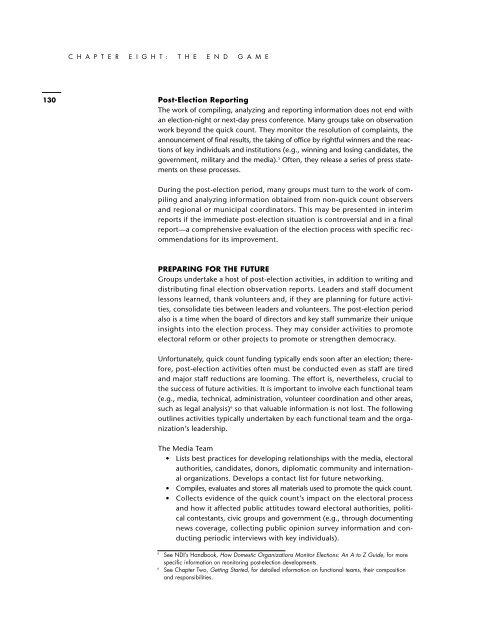The Quick Count and Election Observation
The Quick Count and Election Observation
The Quick Count and Election Observation
You also want an ePaper? Increase the reach of your titles
YUMPU automatically turns print PDFs into web optimized ePapers that Google loves.
C H A P T E R E I G H T : T H E E N D G A M E<br />
130 Post-<strong>Election</strong> Reporting<br />
<strong>The</strong> work of compiling, analyzing <strong>and</strong> reporting information does not end with<br />
an election-night or next-day press conference. Many groups take on observation<br />
work beyond the quick count. <strong>The</strong>y monitor the resolution of complaints, the<br />
announcement of final results, the taking of office by rightful winners <strong>and</strong> the reactions<br />
of key individuals <strong>and</strong> institutions (e.g., winning <strong>and</strong> losing c<strong>and</strong>idates, the<br />
government, military <strong>and</strong> the media). 5 Often, they release a series of press statements<br />
on these processes.<br />
During the post-election period, many groups must turn to the work of compiling<br />
<strong>and</strong> analyzing information obtained from non-quick count observers<br />
<strong>and</strong> regional or municipal coordinators. This may be presented in interim<br />
reports if the immediate post-election situation is controversial <strong>and</strong> in a final<br />
report—a comprehensive evaluation of the election process with specific recommendations<br />
for its improvement.<br />
PREPARING FOR THE FUTURE<br />
Groups undertake a host of post-election activities, in addition to writing <strong>and</strong><br />
distributing final election observation reports. Leaders <strong>and</strong> staff document<br />
lessons learned, thank volunteers <strong>and</strong>, if they are planning for future activities,<br />
consolidate ties between leaders <strong>and</strong> volunteers. <strong>The</strong> post-election period<br />
also is a time when the board of directors <strong>and</strong> key staff summarize their unique<br />
insights into the election process. <strong>The</strong>y may consider activities to promote<br />
electoral reform or other projects to promote or strengthen democracy.<br />
Unfortunately, quick count funding typically ends soon after an election; therefore,<br />
post-election activities often must be conducted even as staff are tired<br />
<strong>and</strong> major staff reductions are looming. <strong>The</strong> effort is, nevertheless, crucial to<br />
the success of future activities. It is important to involve each functional team<br />
(e.g., media, technical, administration, volunteer coordination <strong>and</strong> other areas,<br />
such as legal analysis) 6 so that valuable information is not lost. <strong>The</strong> following<br />
outlines activities typically undertaken by each functional team <strong>and</strong> the organization’s<br />
leadership.<br />
<strong>The</strong> Media Team<br />
• Lists best practices for developing relationships with the media, electoral<br />
authorities, c<strong>and</strong>idates, donors, diplomatic community <strong>and</strong> international<br />
organizations. Develops a contact list for future networking.<br />
• Compiles, evaluates <strong>and</strong> stores all materials used to promote the quick count.<br />
• Collects evidence of the quick count’s impact on the electoral process<br />
<strong>and</strong> how it affected public attitudes toward electoral authorities, political<br />
contestants, civic groups <strong>and</strong> government (e.g., through documenting<br />
news coverage, collecting public opinion survey information <strong>and</strong> conducting<br />
periodic interviews with key individuals).<br />
5<br />
See NDI’s H<strong>and</strong>book, How Domestic Organizations Monitor <strong>Election</strong>s: An A to Z Guide, for more<br />
specific information on monitoring post-election developments.<br />
6<br />
See Chapter Two, Getting Started, for detailed information on functional teams, their composition<br />
<strong>and</strong> responsibilities.


